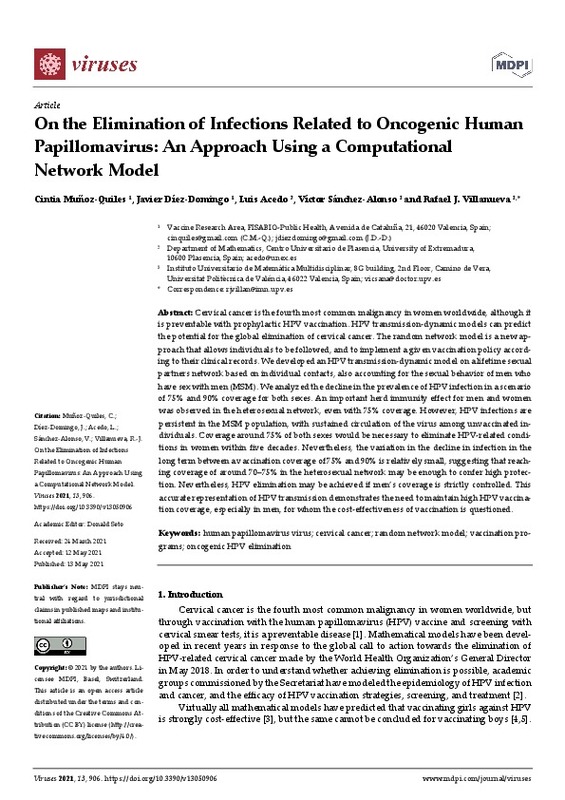JavaScript is disabled for your browser. Some features of this site may not work without it.
Buscar en RiuNet
Listar
Mi cuenta
Estadísticas
Ayuda RiuNet
Admin. UPV
On the Elimination of Infections Related to Oncogenic Human Papillomavirus: an Approach using a Computational Network Model
Mostrar el registro sencillo del ítem
Ficheros en el ítem
| dc.contributor.author | Muñoz-Quiles, Cintia
|
es_ES |
| dc.contributor.author | Diez-Domingo, Javier
|
es_ES |
| dc.contributor.author | Acedo, Luis
|
es_ES |
| dc.contributor.author | Sánchez-Alonso, Víctor
|
es_ES |
| dc.contributor.author | Villanueva Micó, Rafael Jacinto
|
es_ES |
| dc.date.accessioned | 2022-02-21T19:03:45Z | |
| dc.date.available | 2022-02-21T19:03:45Z | |
| dc.date.issued | 2021-05-13 | es_ES |
| dc.identifier.issn | 1999-4915 | es_ES |
| dc.identifier.uri | http://hdl.handle.net/10251/181032 | |
| dc.description.abstract | [EN] Cervical cancer is the fourth most common malignancy in women worldwide, although it is preventable with prophylactic HPV vaccination. HPV transmission-dynamic models can predict the potential for the global elimination of cervical cancer. The random network model is a new approach that allows individuals to be followed, and to implement a given vaccination policy according to their clinical records. We developed an HPV transmission-dynamic model on a lifetime sexual partners network based on individual contacts, also accounting for the sexual behavior of men who have sex with men (MSM). We analyzed the decline in the prevalence of HPV infection in a scenario of 75% and 90% coverage for both sexes. An important herd immunity effect for men and women was observed in the heterosexual network, even with 75% coverage. However, HPV infections are persistent in the MSM population, with sustained circulation of the virus among unvaccinated individuals. Coverage around 75% of both sexes would be necessary to eliminate HPV-related conditions in women within five decades. Nevertheless, the variation in the decline in infection in the long term between a vaccination coverage of 75% and 90% is relatively small, suggesting that reaching coverage of around 70-75% in the heterosexual network may be enough to confer high protection. Nevertheless, HPV elimination may be achieved if men's coverage is strictly controlled. This accurate representation of HPV transmission demonstrates the need to maintain high HPV vaccination coverage, especially in men, for whom the cost-effectiveness of vaccination is questioned. | es_ES |
| dc.description.sponsorship | This work has been supported by the Spanish Ministerio de Economia, Industria y Competitividad (MINECO), the Agencia Estatal de Investigacion (AEI) and Fondo Europeo de Desarrollo Regional (FEDER UE), grant MTM2017-89664-P. Authors also wish to acknowledge Maria Giovanna Ferrario, Victor Latorre, and the Medical Statistics Consulting team (Valencia, Spain) for their collaboration in writing this manuscript. | es_ES |
| dc.language | Inglés | es_ES |
| dc.publisher | MDPI AG | es_ES |
| dc.relation.ispartof | Viruses | es_ES |
| dc.rights | Reconocimiento (by) | es_ES |
| dc.subject | Human papillomavirus virus | es_ES |
| dc.subject | Cervical cancer | es_ES |
| dc.subject | Random network model | es_ES |
| dc.subject | Vaccination programs | es_ES |
| dc.subject | Oncogenic HPV elimination | es_ES |
| dc.subject.classification | MATEMATICA APLICADA | es_ES |
| dc.title | On the Elimination of Infections Related to Oncogenic Human Papillomavirus: an Approach using a Computational Network Model | es_ES |
| dc.type | Artículo | es_ES |
| dc.identifier.doi | 10.3390/v13050906 | es_ES |
| dc.relation.projectID | info:eu-repo/grantAgreement/AEI/Plan Estatal de Investigación Científica y Técnica y de Innovación 2013-2016/MTM2017-89664-P/ES/PROBLEMAS DINAMICOS CON INCERTIDUMBRE SIMULABLE: MODELIZACION MATEMATICA, ANALISIS, COMPUTACION Y APLICACIONES/ | es_ES |
| dc.rights.accessRights | Abierto | es_ES |
| dc.contributor.affiliation | Universitat Politècnica de València. Departamento de Matemática Aplicada - Departament de Matemàtica Aplicada | es_ES |
| dc.description.bibliographicCitation | Muñoz-Quiles, C.; Diez-Domingo, J.; Acedo, L.; Sánchez-Alonso, V.; Villanueva Micó, RJ. (2021). On the Elimination of Infections Related to Oncogenic Human Papillomavirus: an Approach using a Computational Network Model. Viruses. 13(5):1-12. https://doi.org/10.3390/v13050906 | es_ES |
| dc.description.accrualMethod | S | es_ES |
| dc.relation.publisherversion | https://doi.org/10.3390/v13050906 | es_ES |
| dc.description.upvformatpinicio | 1 | es_ES |
| dc.description.upvformatpfin | 12 | es_ES |
| dc.type.version | info:eu-repo/semantics/publishedVersion | es_ES |
| dc.description.volume | 13 | es_ES |
| dc.description.issue | 5 | es_ES |
| dc.identifier.pmid | 34068358 | es_ES |
| dc.identifier.pmcid | PMC8153310 | es_ES |
| dc.relation.pasarela | S\437494 | es_ES |
| dc.contributor.funder | AGENCIA ESTATAL DE INVESTIGACION | es_ES |
| dc.contributor.funder | European Regional Development Fund | es_ES |








